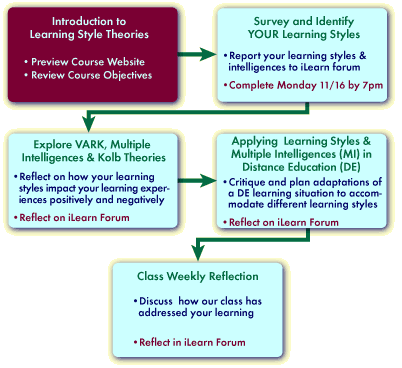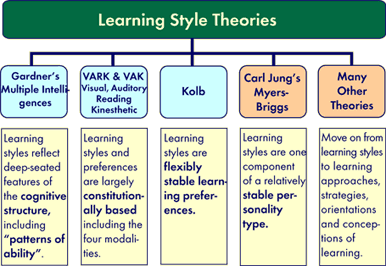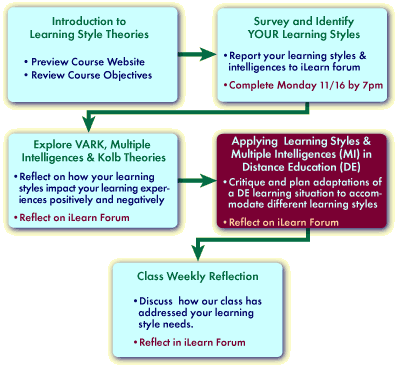Overview
Directly below you will see a diagram illustrating the five main elements of our course learning for the week. You may select the links here to skip to each step or scroll down for explanations about the instructional design. You can download the Learning Styles Overview PDF if you want a printed version with larger images.
Introduction to Learning Style (LS) Theories
Survey and Identify YOUR Learning Styles
Explore VARK, Multiple Intelligences (MI) & Kolb
Apply LS & MI in Distance Education (DE)
Reflect in our 860 Weekly Reflection
....................................
Introduction to Learning Style (LS) Theories

Should We Be Using Learning Styles, a report published by The Learning and Skills Research Center, has an excellent diagram on page 26 showing Families of Learning Styles.
We’ve chosen to study the following 3 theories: Gardner’s Multiple Intelligences, VARK and Kolb. As you can see, each theory looks at a different aspect of learning.

....................................
Survey & Identify YOUR Learning Styles

"One consequence of studying learning styles is the recognition that teachers also have their own approaches to the classroom. While these may have become habitual and while the teacher may define the classroom according to their (not student) preferences, teachers have to acknowledge that their styles will not necessarily suit clusters of students in their classroom. As teachers attempt to modify their classrooms, they need to begin by exploring their own styles."
Using Learning Styles to Adapt Technology for Higher Education. Terry O'Connor, Indiana State University. **Note: Link broken - resource missing (as of March, 2013)
....................................
Explore VARK, Multiple Intelligences & Kolb Theories

"When the opportunities offered by new advances in electronic information processing technologies are combined with the new view of the learning process provided by learning style research, the promise to revolutionize the teaching paradigms found in the academy begins to gain some direction."
Using Learning Styles to Adapt Technology for Higher Education. Terry O'Connor, Indiana State University. **Note: Link broken - resource missing (as of March, 2013)
....................................
Applying Learning Styles and Multiple Intelligences in DE

"It is a truism in media that people first tend to use new technology the same way they used to using older technology."
"In this context, the tendency is to use computing technology to deliver the same kinds of instruction & testing that are currently offered in the traditional college classroom. We assume that the same patterns, the same content centeredness, the same student relations, and the same tasks (repeating known answers) should be electronically replicated. Eventually, applications of computing technology will challenge these assumptions and free us from the need to stay trapped in older college paradigms."
Using Learning Styles to Adapt Technology for Higher Education. Terry O'Connor, Indiana State University. **Note: Link broken - resource missing (as of March, 2013)
....................................
Class Weekly Reflection
